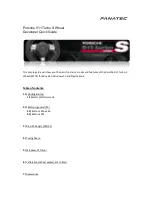
Note:
In case of emergency, you can add a
large amount of water without coolant in
order to reach a vehicle service location.
Water alone, without coolant, can cause
engine damage from corrosion, overheating
or freezing. When you reach a service
location, you must have the cooling system
drained, flushed and refilled using the
correct specification prediluted coolant or
antifreeze concentrate. See
Do not use the following as a coolant
substitute:
•
Alcohol.
•
Methanol.
•
Brine.
•
Any coolant mixed with alcohol or
methanol antifreeze.
Alcohol and other liquids can cause engine
damage from overheating or freezing.
Do not add extra inhibitors or non-specified
additives to the coolant. These can be
harmful and compromise the corrosion
protection of the coolant.
Engine and Secondary Cooling
System Refill Procedure
The following procedure should be used
when refilling the engine or secondary
cooling systems after it has been drained
or become extremely low:
1.
Before you remove the cap, turn the
engine off and let it cool.
2. When the engine is cool, wrap a thick
cloth around the cap. Slowly turn cap
counterclockwise until pressure begins
to release.
3. Step back while the pressure releases.
4. When you are sure that all the pressure
has been released, use the cloth to turn
it counterclockwise and remove the
cap.
5. Slowly add prediluted engine coolant
to the coolant reservoir until the
coolant level is within the minimum
and maximum range as listed on the
reservoir.
6. Reinstall the pressure relief cap.
7.
Start and run the engine at 2000 rpm
for 2 minutes.
8. Shut engine off, and remove the
pressure relief cap as previously
outlined.
9. If required, add prediluted engine
coolant to the coolant reservoir until
the coolant level is within the minimum
and maximum range as listed on the
reservoir.
10.
Engine cooling system:
Repeat
Step 5 until the coolant level has
stabilized (is no longer dropping after
each step) and the upper radiator
hose at the radiator is warm to the
touch (indicating that the engine
thermostat is open and coolant is
flowing through the radiator).
11.
Check the secondary cooling system.
Repeat Step 5 until the coolant level
has stabilized (is no longer dropping
after each step) and the lower
passenger side of the secondary
radiator is warm to the touch
(indicating secondary thermostat is
open and coolant is flowing through
the entire system).
12.
Reinstall the pressure relief cap. Shut
the engine off and let it cool.
13.
Check the coolant level in the
reservoir before you drive your vehicle
the next few times.
14.
If necessary, add prediluted engine
coolant to the coolant reservoir until
the coolant level is within the
minimum and maximum range as
listed on the reservoir. After any
coolant has been added, check the
coolant concentration.
196
F650750 (TBC) , enUSA, Edition date: 201708, First Printing
Maintenance
Summary of Contents for F-650 2018
Page 3: ......
Page 9: ...6 F650750 TBC enUSA Edition date 201708 First Printing...
Page 247: ...E161437 244 F650750 TBC enUSA Edition date 201708 First Printing Wheels and Tires...
Page 278: ...E240522 275 F650750 TBC enUSA Edition date 201708 First Printing Capacities and Specifications...
Page 354: ...Van E239122 Truck E239121 351 F650750 TBC enUSA Edition date 201708 First Printing Appendices...
Page 377: ...374 F650750 TBC enUSA Edition date 201708 First Printing...
















































